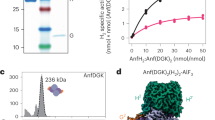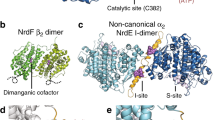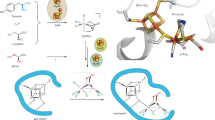Abstract
THE principal driving forces of protein folding are the burial of hydrophobic residues in the interior of proteins and the exposure of charged residues at the surface1. Charged residues are only occasionally found in the interior, where they form hydrogen bonds to oppositely charged residues or main-chain atoms2. Ribonucleotide reductase, a key enzyme in DNA synthesis, catalyses the de novo production of deoxyribonucleotide precursors. It is composed of two different dimeric proteins Rl and R2 (refs 3–5). R2 subunits contain buried iron-centres with each centre formed by two ferric ions coordinated by four carboxylates and two histidine ligands6. Iron-free R2, apoR2, is a precursor of active R2 and folds into a stable protein which is transformed into active R2 by ferrous ions and molecular oxygen. Here we show that the iron-free protein does not undergo any major structural changes compared with the iron-containing R2. The effect of this is a clustering of four carboxyl side chains in the interior of the subunit, in contrast to the normal distribution of charged residues in proteins.
This is a preview of subscription content, access via your institution
Access options
Subscribe to this journal
Receive 51 print issues and online access
$199.00 per year
only $3.90 per issue
Buy this article
- Purchase on Springer Link
- Instant access to full article PDF
Prices may be subject to local taxes which are calculated during checkout
Similar content being viewed by others
References
Brändén, C. & Tooze, J. Introduction to Protein Structure (Garland, New York, 1991).
Baker, E. N. & Hubbard, R. E. Prog. Biophys. molec. Biol. 44, 97–179 (1984).
Stubbe, J. A. A. Rev. Biochem. 58, 257–285 (1989).
Eriksson, S. & Sjöberg, B.-M. in Allosteric Enzymes (ed. Hervé, G.) 189–215 (CRC, Boca Raton, Florida, 1989).
Fontecave, M., Nordlund, P., Eklund, H. and Reichard, P. Adv. Enzymol. 65, 147–183 (1992).
Nordlund, P., Sjöberg, B.-M. & Eklund, H. Nature 276, 593–598 (1990).
Nordlund, P. et al. FEBS Lett. 258, 251–254 (1989).
Davies, D. A. Rev. biophys. Chem. 19, 189–215 (1989).
Schneider, G., Eklund, H., Cedergren-Zeppezauer, E. & Zeppezauer, M. Proc. natn. Acad. Sci. U.S.A. 80, 5289–5293 (1983).
Rees, D. C. & Lipscomb, W. N. Proc. natn. Acad. Sci. U.S.A. 80, 7151–7154 (1983).
Nar, H., Messerschmidt, A., Huber, R., van de Kamp, M. & Canters, G. W. FEBS Lett. 306, 119–124 (1992).
Reeke, G. N. J., Becker, J. W. & Edelman, G. M. Proc. natn. Acad. Sci. U.S.A. 75, 2286–2290 (1978).
Shoham, M. et al. J. molec. Biol. 131, 137–155 (1979).
Bajorath, J., Raghunathan, S. Hinricks, W. & Saenger, W. Nature 337, 481–484 (1989).
Anderson, B. F., Baker, H. M., Norris, G. E., Rumball, S. V. & Baker, E. N. Nature 344, 784–787 (1990).
Atta, M., Nordlund, P., Åberg, A., Eklund, H. & Fontecave, M. J. biol. Chem. 676, 20682–20688 (1992).
Stubbe, J. Curr. Opin. struct. biol. 1, 788–795 (1991).
Frausto da Silva, J. J. R. & Williams R. J. P. The Biological Chemistry of the Elements (Clarendon, Oxford, 1991).
Stroud, R. M., McCarthy, M. P. & Shuster, M. Biochemistry 29, 11009–11023 (1990).
Yang, A.-S. & Honig, B. Curr. Opin. struct. biol. 2, 40–45 (1992).
Atkin, C. L., T. L., Reichard, P. & Lang, G. J. biol. Chem. 248, 7664–7472 (1973).
Blum, M., Metcalf, P., Harrison, S. C. & Wiley, D. C. J. appl. Crystallogr. 20, 235–242 (1987).
Brünger, T. A., Kuriyan, J. & Karplus, M. Science 235, 458–460 (1987).
Jones, T. A. Meth. Enzym. 115, 157–171 (1985).
Jones, T. A., Bergdoll, M. & Kjeldgaard, M. in Crystallographic and Modeling Methods in Molecular Design (eds Bugg, C. & Ealick, S.) 189–199 (Springer, New York, 1990).
Author information
Authors and Affiliations
Rights and permissions
About this article
Cite this article
Åberg, A., Nordlund, P. & Eklund, H. Unusual clustering of carboxyl side chains in the core of iron-free ribonucleotide reductase. Nature 361, 276–278 (1993). https://doi.org/10.1038/361276a0
Received:
Accepted:
Published:
Issue Date:
DOI: https://doi.org/10.1038/361276a0
This article is cited by
-
Linocin M18 protein from the insect pathogenic bacterium Brevibacillus laterosporus isolates
Applied Microbiology and Biotechnology (2023)
-
Class Id ribonucleotide reductase utilizes a Mn2(IV,III) cofactor and undergoes large conformational changes on metal loading
JBIC Journal of Biological Inorganic Chemistry (2019)
-
Assembly of nonheme Mn/Fe active sites in heterodinuclear metalloproteins
JBIC Journal of Biological Inorganic Chemistry (2014)
-
An unusual buried polar cluster in a family of fungal lipases
Nature Structural & Molecular Biology (1994)
Comments
By submitting a comment you agree to abide by our Terms and Community Guidelines. If you find something abusive or that does not comply with our terms or guidelines please flag it as inappropriate.



